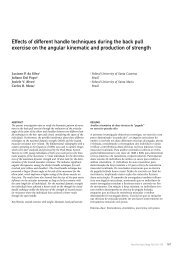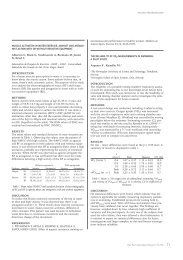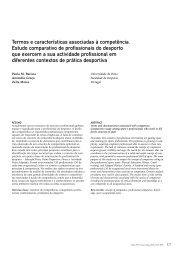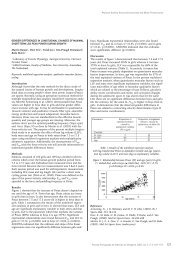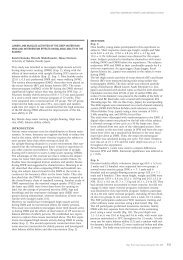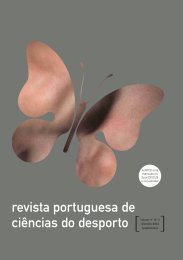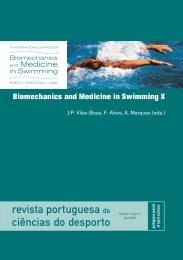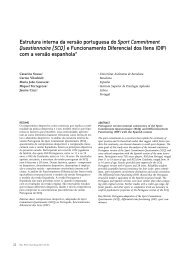download PDF - Faculdade de Desporto da Universidade do Porto
download PDF - Faculdade de Desporto da Universidade do Porto
download PDF - Faculdade de Desporto da Universidade do Porto
You also want an ePaper? Increase the reach of your titles
YUMPU automatically turns print PDFs into web optimized ePapers that Google loves.
70<br />
Comunicações<br />
ANÁLISIS DEL MINUTO DE GOL EN EL CAMPEONATO DEL MUNDO<br />
MASCULINO Y FEMENINO DE HOCKEY HIERBA (2006)<br />
Rebeca Piñeiro Mosquera<br />
Facultad <strong>de</strong> Ciencias <strong>de</strong> la Activi<strong>da</strong>d Física y <strong>de</strong>l Deporte - Universi<strong>da</strong>d<br />
Politécnica <strong>de</strong> Madrid<br />
El objetivo <strong>de</strong> este estudio fue conocer la influencia que tiene el<br />
minuto en el que se consiguen los goles en el hockey hierba <strong>de</strong><br />
alto rendimiento. Se analizaron 289 goles consegui<strong>do</strong>s en 84<br />
parti<strong>do</strong>s <strong>de</strong>l campeonato <strong>de</strong>l mun<strong>do</strong> masculino y femenino <strong>de</strong><br />
categoría absoluta <strong>de</strong> la tempora<strong>da</strong> 2006. Nos planteamos los<br />
siguientes objetivos en nuestro estudio: <strong>de</strong>terminar el minuto<br />
<strong>de</strong> gol según perio<strong>do</strong> <strong>de</strong> juego, conocer cuan<strong>do</strong> se produce la<br />
acción <strong>de</strong> gol según intervalos <strong>de</strong> tiempo <strong>de</strong> 10 minutos y ver<br />
si existen diferencias entre hombres y mujeres en el minuto <strong>de</strong><br />
gol. El estudio muestra que la frecuencia <strong>de</strong> goles marca<strong>do</strong>s<br />
durante el parti<strong>do</strong> <strong>de</strong>pen<strong>de</strong> <strong>de</strong>l tiempo. En la primera parte se<br />
producen el 44 % <strong>de</strong> los goles y en la segun<strong>da</strong> parte el 56 % <strong>de</strong><br />
los goles. Existe un significativo aumento en el número <strong>de</strong> goles<br />
en el transcurso <strong>de</strong>l parti<strong>do</strong> como se observa en los interv a l o s<br />
<strong>de</strong> 10 minutos. Las mujeres marcan más goles en la primera<br />
parte (51 %) que los hombres (39 %) y los hombres marcan<br />
más goles en la segun<strong>da</strong> parte (61 %) que las mujeres (49 %).<br />
Palabras clave: Hockey Hierba, Minuto <strong>de</strong> Gol, Eficacia<br />
Ofensiva, Rendimiento, Género<br />
¿ES EL PRIMER GOL UNA VARIABLE DE ÉXITO EN EL HOCKEY<br />
HIERBA DE ALTO RENDIMIENTO?<br />
Rebeca Piñeiro Mosquera<br />
Facultad <strong>de</strong> Ciencias <strong>de</strong> la Activi<strong>da</strong>d Física y <strong>de</strong>l Deporte - Universi<strong>da</strong>d<br />
Politécnica <strong>de</strong> Madrid<br />
El objetivo <strong>de</strong> este estudio fue conocer la influencia que tiene<br />
la variable primer gol en relación con el resulta<strong>do</strong> final <strong>de</strong>l parti<strong>do</strong>.<br />
Se analizaron 324 parti<strong>do</strong>s <strong>de</strong> hockey hierba <strong>de</strong> nivel<br />
internacional <strong>de</strong> diferentes categorías: absoluta, sub 21, sub 18,<br />
sub 16. Estos parti<strong>do</strong>s correspon<strong>de</strong>n a competiciones disputa<strong>da</strong>s<br />
en la tempora<strong>da</strong> 2005-2006. Nos planteamos los siguientes<br />
objetivos en nuestro estudio: conocer si el primer gol en el<br />
encuentro es <strong>de</strong>terminante para ganar el parti<strong>do</strong>, averiguar si<br />
existen diferencias entre las cuatro categorías, absoluta, sub 21,<br />
sub 18 y sub 16 en relación a la variable primer gol, ver si existen<br />
diferencias <strong>de</strong> género en relación a la variable primer gol y<br />
por último, conocer <strong>de</strong> qué forma influye el minuto en que se<br />
marca el primer gol en el resulta<strong>do</strong> final <strong>de</strong>l parti<strong>do</strong>.<br />
Palabras clave: Hockey Hierba, Primer gol <strong>de</strong>l parti<strong>do</strong>,<br />
Resulta<strong>do</strong> Final, Rendimiento, Género, Señor, Sub21, Sub18 y<br />
Sub16.<br />
Rev Port Cien Desp 7(Supl.1) 21–84<br />
PHYSIOLOGICAL IMPACT OF FOOTBALL ON PRE-PUBERTAL<br />
YOUNG ATHLETES<br />
Renato Fernan<strong>de</strong>s 1 & F.D. Pereira 2<br />
1 Escola Superior <strong>de</strong> <strong>Desporto</strong> - Instituto Politécnico <strong>de</strong> Santarém,<br />
Portugal 2 <strong>Facul<strong>da</strong><strong>de</strong></strong> <strong>de</strong> Motrici<strong>da</strong><strong>de</strong> Humana - Universi<strong>da</strong><strong>de</strong> Técnica<br />
<strong>de</strong> Lisboa<br />
Regular physical activity has proved to be beneficial for health<br />
promotion. Do a sport like football promote a metabolic specialization<br />
in pre-pubertal children? To answer this question we<br />
assessed a group of young athletes engaged in competitive<br />
football teams for two years of practice. Physical performance<br />
was tested in laboratorial context for prolonged maximal power<br />
output with a treadmill (VO 2max) and for short-term power output<br />
with a cycle-ergometer (Wingate Test- WAnT arm and leg<br />
evaluations).<br />
The WAnT allows a practical assessment for both legs and arms<br />
performance (2). Assuming the specificity of the anaerobic<br />
capacity for the main requested muscle groups (3), probably,<br />
football players willhave good performances in legs than with<br />
their arms.<br />
A group of young athletes (n=11; age: 11,5 years ± 0,52;<br />
weight: 41,00 kg ± 5,71; BMI: 18,09 kg/m 2 ± 1,59) with a<br />
two year of training practice in football, performed the tests.<br />
Modified Balke maximal protocol using ergo-spirometry procedures<br />
(Cosmed® b 2 ) was selected to <strong>de</strong>termine VO 2max and the<br />
Ventilatory Anaerobic Threshold (VAT) as estimates for the<br />
aerobic capacity. The anaerobic capacity for both arms and legs<br />
was quantified using the WAnT, performed in a cycle-egometer<br />
(Monark® 849). Three relative parameters were assessed: Peak<br />
Power, Average Power and Power Drop. The <strong>da</strong>ta was correlated in<br />
the group (SPSS, ver.12.0).<br />
The <strong>de</strong>scriptive results are shown in Table 1. A significant correlation<br />
between VO 2max and VAT (p



